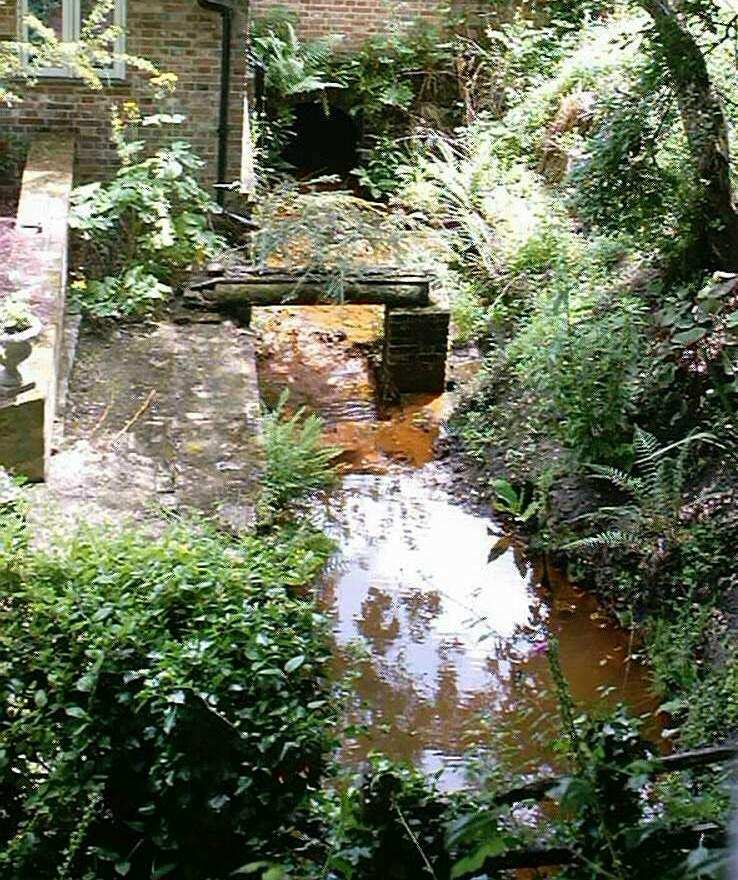
| Home | History | Gazetteers | Museums | Sources |
| EAST SUSSEX | WEST SUSSEX | KENT | SURREY | HAMPSHIRE |
Ashburnham, near Battle TQ 685173
This was an important Wealden ironwork complex of furnace, forges and boring mills, built by John Ashburnham before 1554, and the last Wealden furnace to close in 1813, although the forge continued until the late 1820s. The sites worked together during the Civil War, the premier Wealden ordnance suppliers until about 1760, and later produced guns and shot for the Dutch Wars. The main furnace pond is now dry, but a secluded pen pond survives on private land just north of the furnace site in Andersons Wood (685173).
An unmade road, heavily metalled with waste iron slag, runs about half a mile between this remaining furnace pen pond and the dry site of Ashburnham (Upper) Forge. Known originally as the ‘sow track’, this not only took sows and guns from the furnace down to the forge and boring mill but also extended up past Robertsbridge to Sedlescombe, where iron goods were shipped to London via the river Brede.
The track starts as a modern road over the bay of Ashburnham (Upper) Forge (687162). Part of the forge pond survives just to the west by a road on private land at 684161, with a modern weir. Looking down east from the bridge here, a rusty channel can clearly be seen far below, running under the conservatory of Forge Cottage. This was the original pit for the forge wheel and part of the old tail-race survives across it (below).

North along the track down a detour right at the path fork (685172) there is a footbridge over a rusty ford with several large reddish ‘bears’ in the stream: a bear is a rock of imperfectly smelted ore and iron. Slightly further along, left in a private meadow, a high bank is visible. This is the old furnace bay, and the furnace pond, now dry, lay beyond it. This is now a low field. The old spillway is roughly halfway along the bay and still serves a stream – depending on the overgrowth, this may be seen as well as heard.
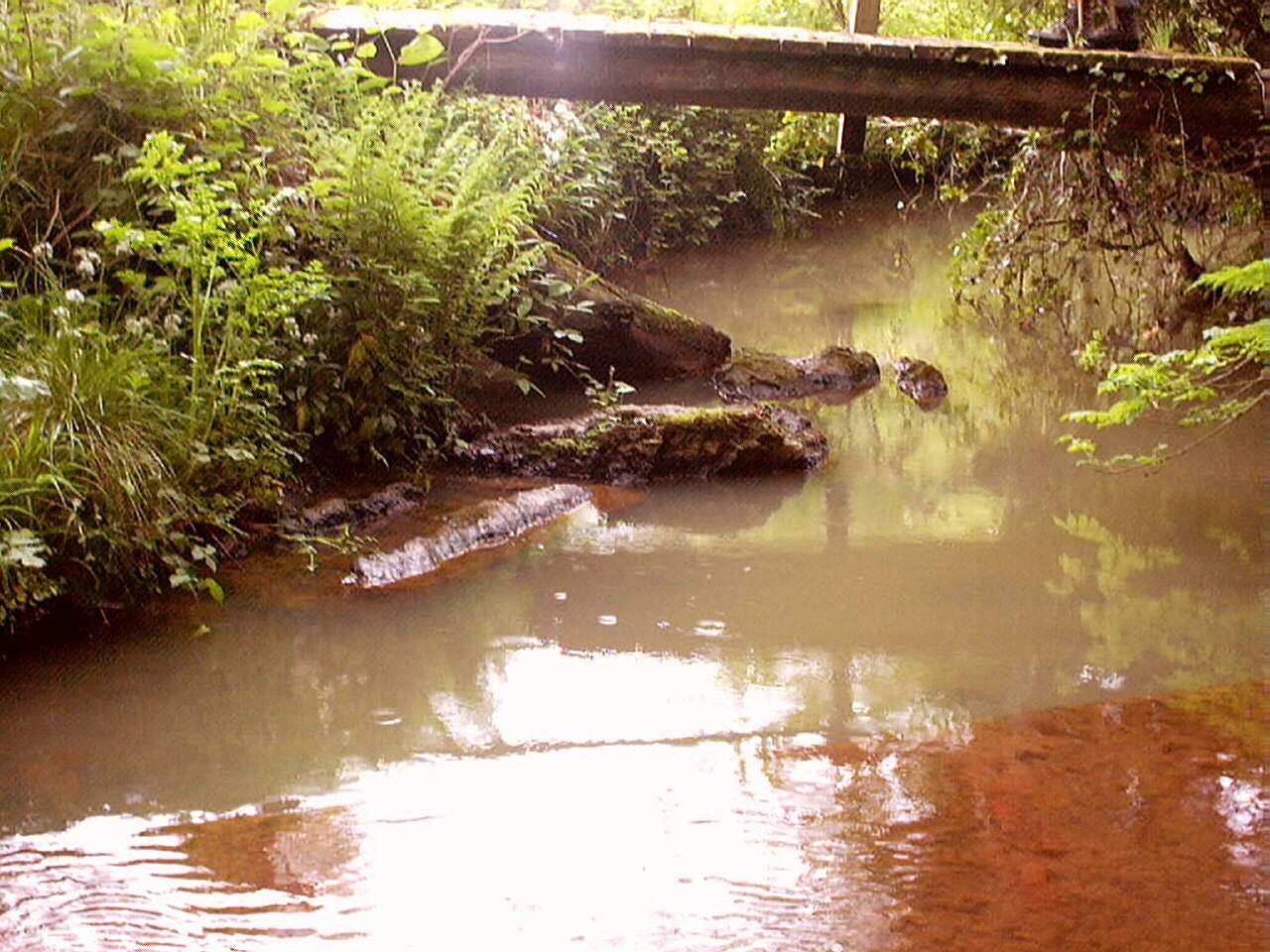
Rusty bears visible in the stream near Ashburnham Furnace
Retracing our steps back to the original track and moving north, we come to a terrace of old brick and tile cottages adjacent to the furnace bay. The first, Furnace Cottage, popularly known as Pay Cottage, has a small square window nearest the gate said to be where the ironworkers collected their wages. The track continues up to the other end of the furnace pond bay (no public access) and then further north passing the furnace’s pen pond in Andersons Wood on the left. These waters are on private land, but the red stream bottom is clearly visible from the nearby bridge, where a small spillway lets the stream run into a dry wood on the other side - an area which was once part of the furnace pond.
Young ironworker William Hobday often spoke of the end of the furnace’s last campaign, as reported in his obituary in the Sussex Express in 1883. Sadly, he revealed that a six-year-old boy also present drank a whole bottle of gin, and was dead before the doctor came (SIAS, 1983: 3). Rumour holds that inebriation allowed the fire to go out prematurely on that particular day.
Buxted TQ 477272
Oldlands Furnace Pond still holds water on private land north of Furnace Woods in the hamlet of Heron’s Ghyll, northeast of Buxted. No public access. William Basset operated the furnace in 1593, possibly in conjunction with Crowborough Forge. It was leased out at least until 1617. It’s often claimed that Ralph Hogge worked this site, but there is no evidence of this. Hogge was the trainee colleague and later successor of Peter Baude who cast the first one-piece cast-iron cannon, probably at Queenstock furnace at Iron Plat nearby. Hogge’s iron rebus, or personal stamp, is above the door at the entrance to Buxted Park, a few miles south of here.
Eridge, near Frant TQ 564350
Lord Abergavenny owned Eridge Furnace, and there are records of French workers, presumably skilled blast furnace operators, on site since 1538. This is one of the bigger ponds, set in woodlands, with pen ponds upstream. The church here has some seventeenth century iron graveslabs for the Fowles, a local iron family, in the aisle, but these are now covered by carpet.
Framfield (east) TQ 515211
Tickerage Furnace and Forge Pond are believed to have existed at separate times due to the restricted space, but the forge functioned from around 1617 to 1664 in what is now the nearby mill house garden. This is one of the smaller ponds within a peaceful scenic setting with several interesting features. The original spillway and millrace remain on the bay, with a ferruginous stream running through the leat of the later corn mill building.
Pounsley Furnace, eastwards along Tickerage Stream, was also a major cannon producer. The old gun banks for test firing new cannon survive at Pounsley Mill Farm, but the pond is now dry.
Framfield (south) TQ 509195
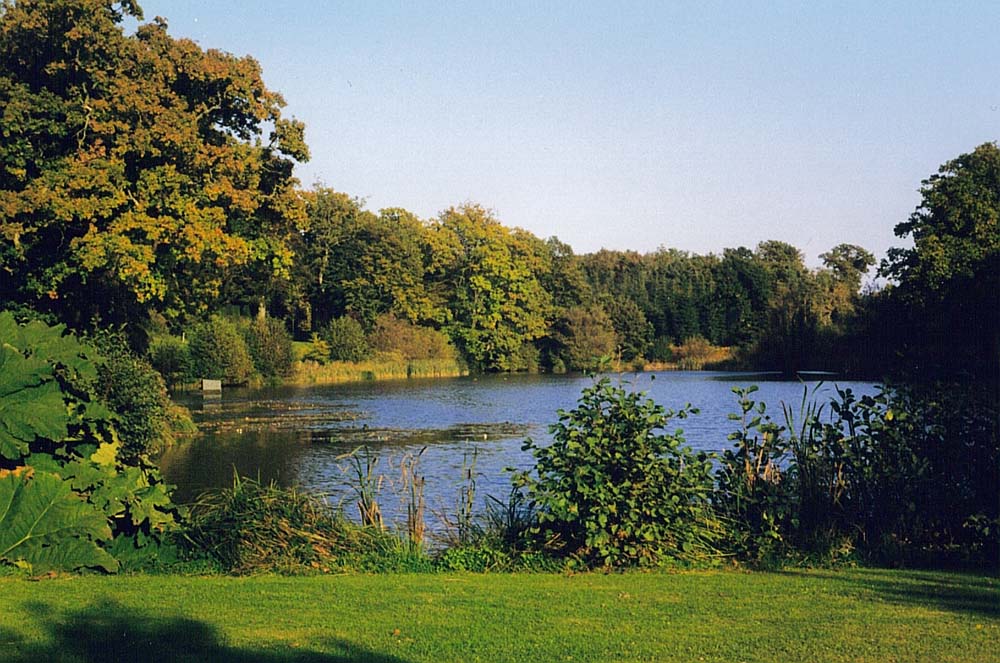
This is believed to be the site of New Place Furnace, circa 1560, but it has been extensively altered and landscaped. There is an interesting chain of ponds and spillways along the stream on private land but viewable from the Wealdway footpath. Nearby Blackboys got its name from the local charcoal burners, then known as ‘wood colliers’.
Furner’s Green TQ 416257
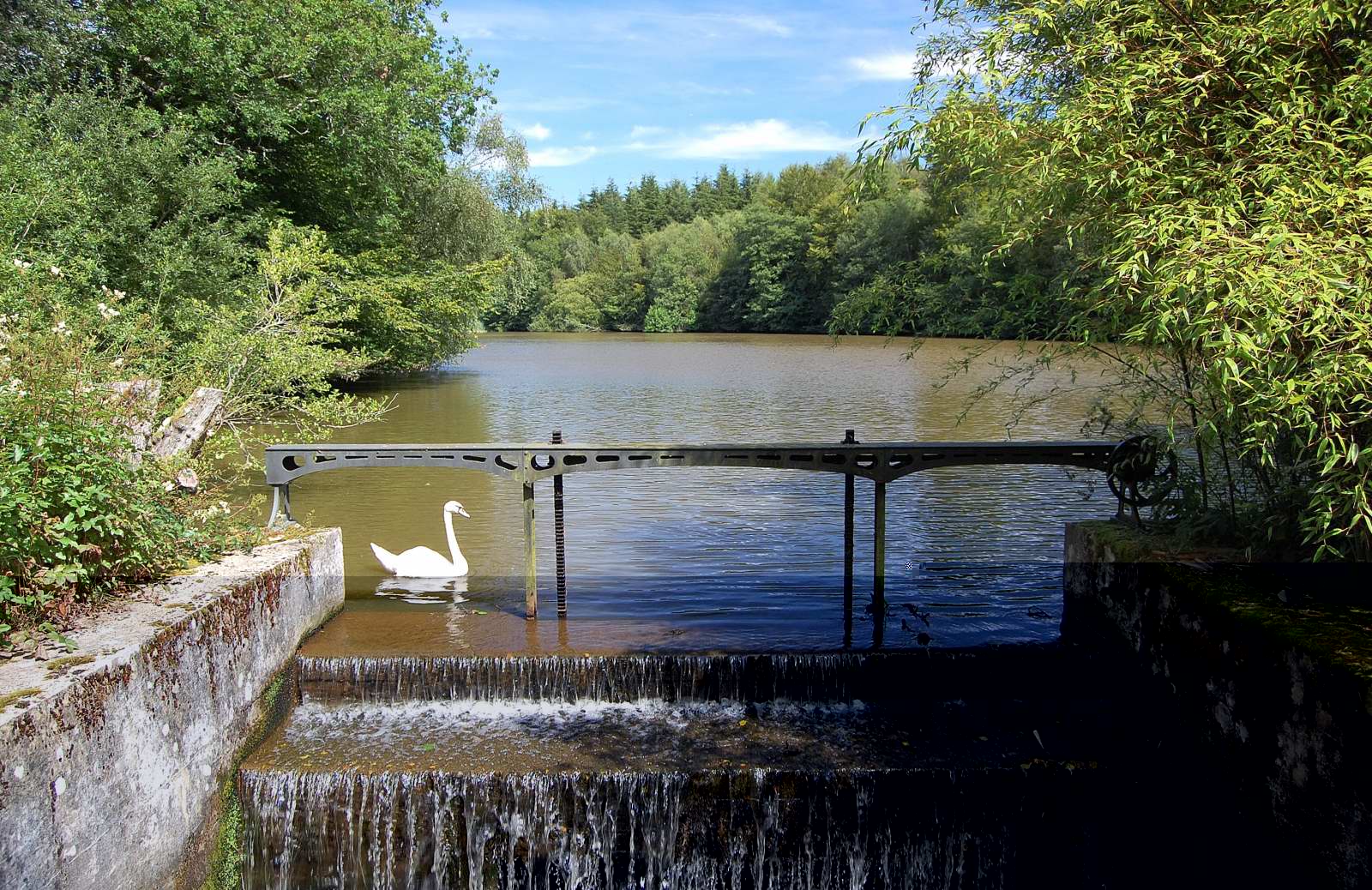
Sheffield Furnace was established by 1546 but had been converted to a corn mill by 1597. An impressive spillway in the middle of the pond bay is probably original. The bay sits on a footpath along a private track in the hamlet of Furner’s Green. Sheffield Park Gardens’ ornamental lakes, to the south, have no connection with the furnace or forge
Hamsell, near Eridge TQ 538344
Hamsell Furnace was owned by John Waller until his death in 1567, when it was occupied and operated by John Baker. By l692 it was producing shells and eventually cast shot until around 1758. The furnace was demolished by 1787. The bay area has since been landscaped and the much-altered lake is on private land. No public access but you can just glimpse the waters through trees by a gate on a footpath.
Heathfield TQ 594196
John Fuller of Brightling built Heathfield Furnace in 1693. He was a primary ordnance supplier to Ireland, Sardinia and Naples as well as the British government: two of his guns stand by the Tower of London. The ironworks ceased production in 1793. The furnace pond was near the hamlet of Old Heathfield, but has since been drained and the bay damaged. A chain of four pen ponds survives upstream within the private Heathfield Park. Originally there were twelve according to a 1795 estate map (C&C, 1995: 335), presumably necessary due to local watershed difficulties. No public access. Another small pen pond survives together with part of the old brick spillway at TQ 594196, down a muddy public footpath.
Herstmonceux
TQ 632153
Lessees
Thomas Glydd and Simon Colman built Batsford Furnace on what was then the
Batsford Brook here in 1571, north of Herstmonceux. Dry for many years, the old
bay was breached by the stream. A new bay was constructed close to the old site
during landscaping in the late 1970s, and the pond refilled for a new fish farm.
It is now a private fishing lake, Furnace Brook Fishery, on a lane east from
Cowbeech (see their Facebook page for photographs etc).
Maresfield TQ 460228
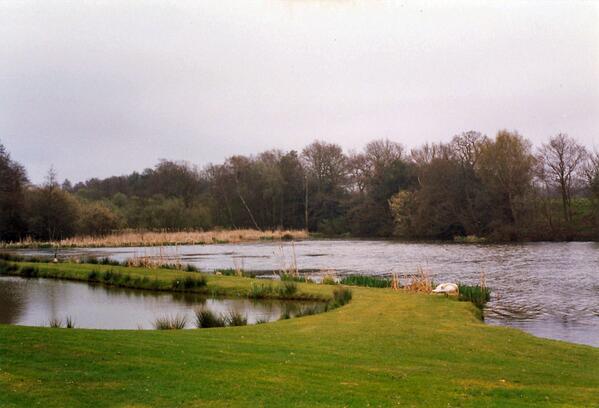
Maresfield Forge was established by John Gage and worked from before 1574 until after 1724. For some time the forge supplied a shop in Lewes High Street with bar iron and tools. This much altered lake, at the end of a chain of smaller ponds, was used by a powder mill in the nineteenth century. It is on private land, but a footpath runs alongside. An iron grave slab for Robert Brooks is stored in the tower of St Bartholomew’s Church. Budletts Common nearby is almost certainly associated with the local iron industry: ‘budlett’ was a place-name for a site where iron ore was washed (Straker, 1931: xii).
Riverhall, near Wadhurst TQ 605333
Riverhall Furnace was operated by Nicholas Fowle in 1562, and last worked in 1653. The furnace was within the grounds of nearby Riverhall Mansion, constructed by the prosperous Fowle in 1591. However two pen ponds survive but only one, at the GR above, is clearly visible from the road, which crosses a small ferruginous stream just before the pond.
Scarlets Lake, near Cowden TQ 443401
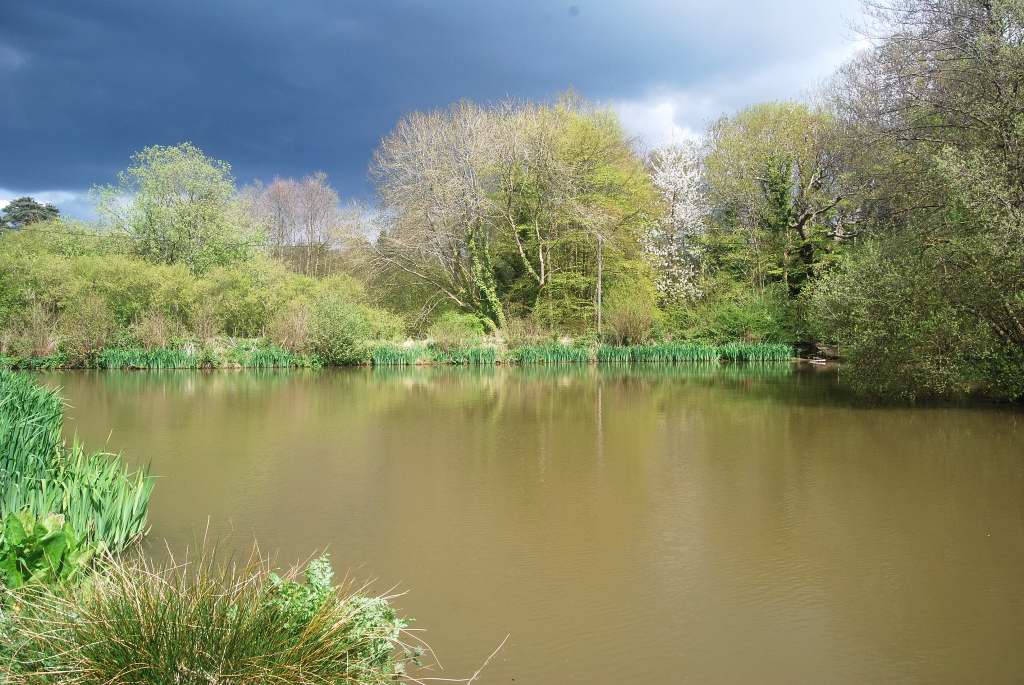
This pond, once dry but restored in 1977, powered Scarlet’s Furnace for Francis Knight in 1590. A gun casting pit was uncovered here near the site of the old furnace at the north end of the bay. The site was still in service in the 1690s making ordnance, and was later used as a corn mill. Scarlet’s Furnace Pond lies on a bridleway by the border between East Sussex and Kent, just west of Cowden Furnace Pond (see Kent). The bridleway passes over the bay of the pond, and an old ruined sluice lies on the south of the bay. A few artefacts from both of these furnaces are on display at the Eden Valley Museum
Photos and text © Helen Pearce 2018